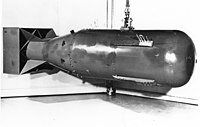
Photo from wikipedia
Abstract Industrial plastic parts, made of semi-crystalline polymers, are often produced by injection molding. In this process the melt undergoes a complex deformation and cooling history which results in an… Click to show full abstract
Abstract Industrial plastic parts, made of semi-crystalline polymers, are often produced by injection molding. In this process the melt undergoes a complex deformation and cooling history which results in an inhomogeneous distribution of spherulites in the component. The different size and shape of the spherulites induce local variations of the elastic properties in the final part. To evaluate these inhomogeneities in an isotactic polypropylene (α-iPP) component accurately, a 3D multi-scale, integrated simulation approach has been developed. At first, a coupled mold filling and heat transfer analysis is achieved at the macro-scale and the predicted velocity and temperature fields are transferred to the micromodel. Then, a 3-D microstructure evolution model is developed, where the nucleation of spherulite germs and their growth are described. To evaluate their effective mechanical properties a two-level homogenization scheme has been adopted. At the nano-scale, the effective properties of the lamella build of crystalline and amorphous phases are determined. In this study, not only the radial growing lamella of amorphous and crystalline phases is homogenized, but also its “cross hatched” lamellar structure. At the micro-scale, the spherulite microstructure is homogenized via a 3D radial distribution of equivalent lamellae around its mono-crystal center. Finally, the application of the developed homogenization scheme allows the prediction of the distribution of effective mechanical properties over the component thickness in different sections of the staggered component.
Journal Title: Mechanics of Materials
Year Published: 2017
Link to full text (if available)
Share on Social Media: Sign Up to like & get
recommendations!